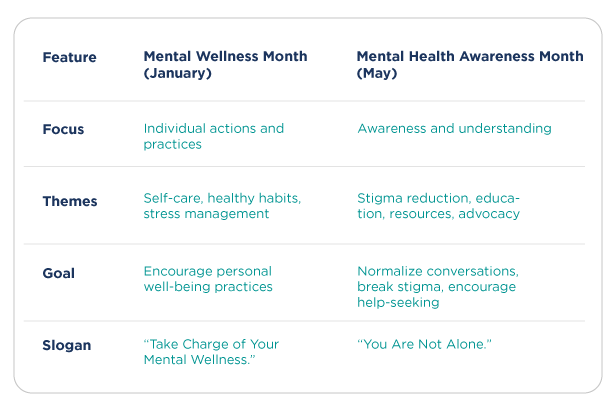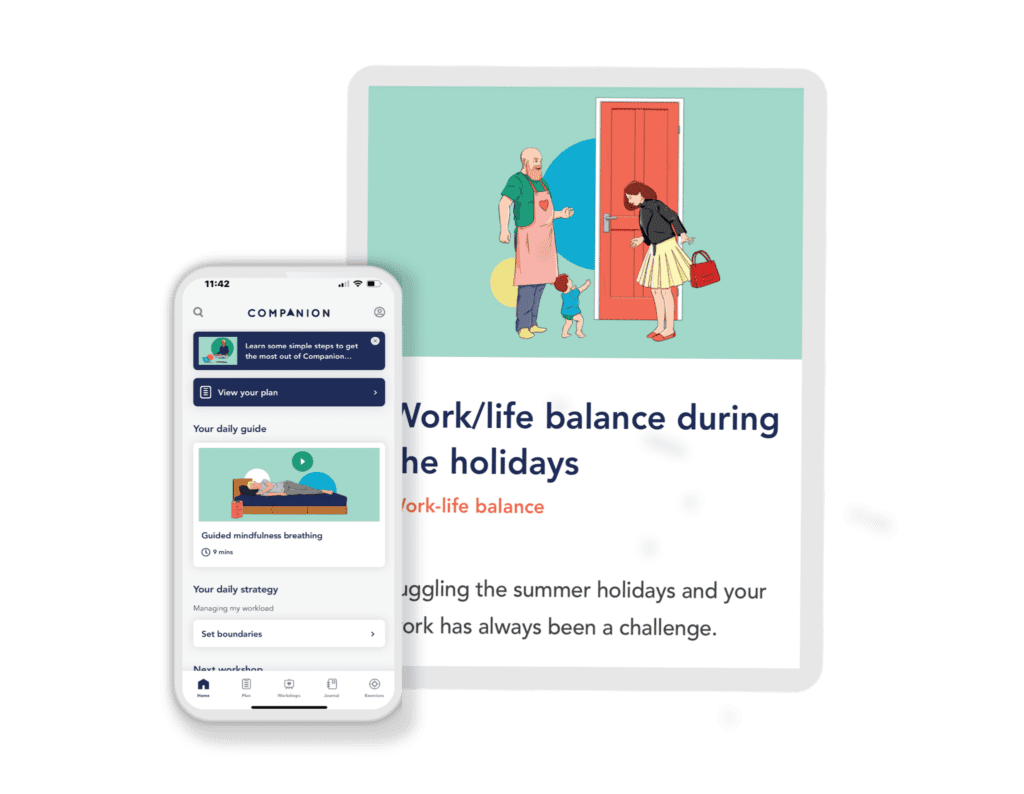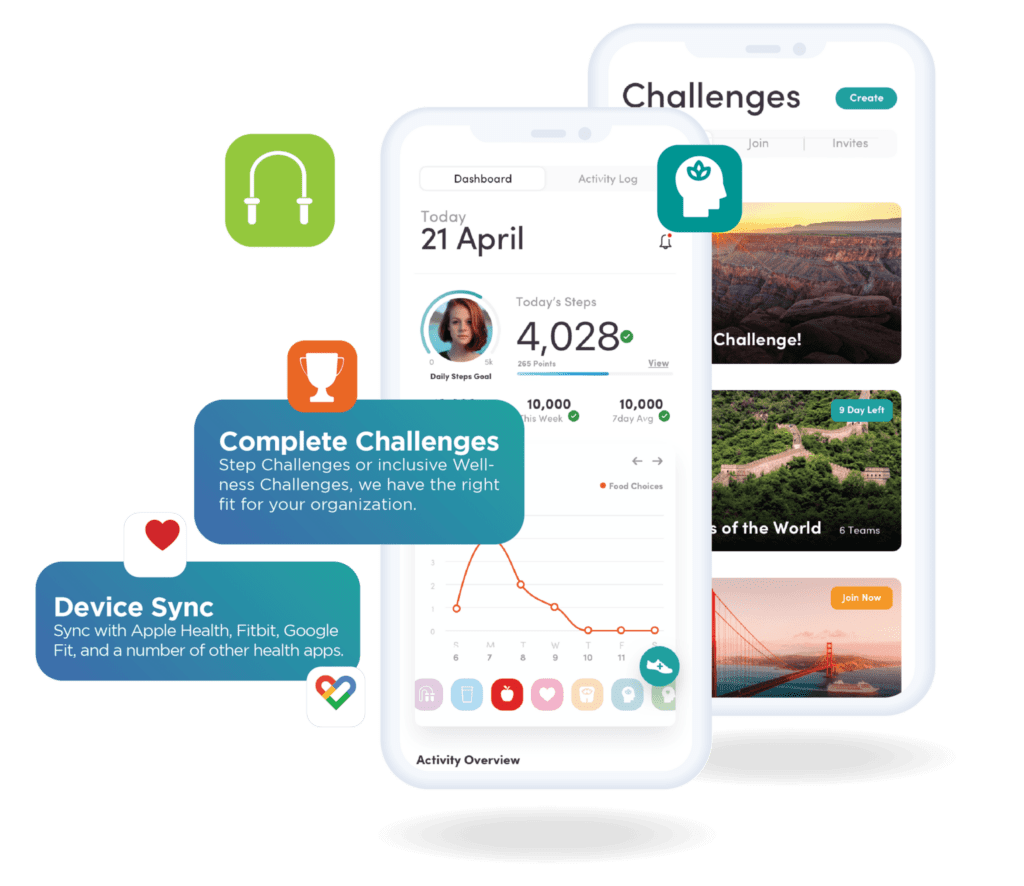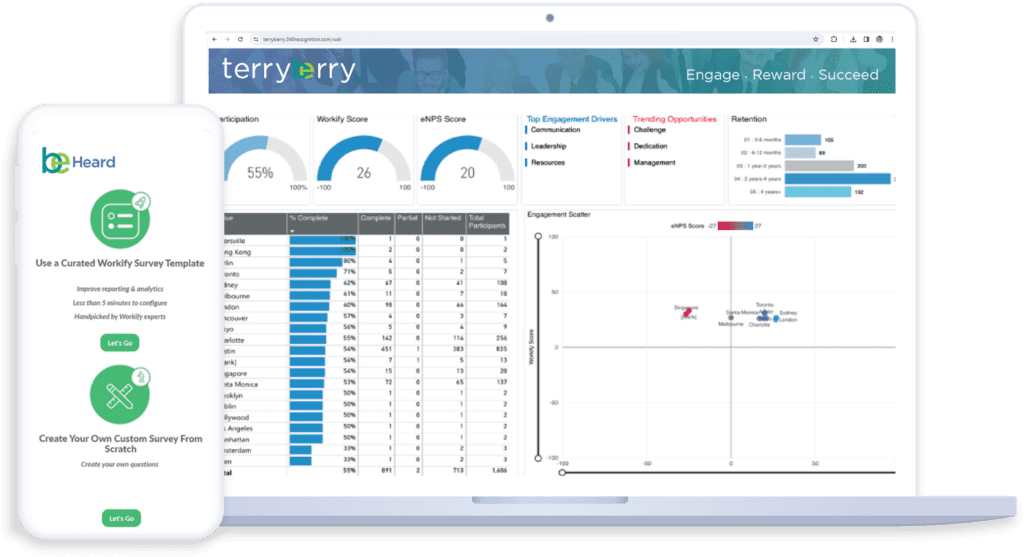March 1, 2024


Many of us still grapple with the importance of prioritizing mental wellness in our personal lives and the workplace. The hustle and bustle of daily life (compounded by the ever-present challenges and stresses) make it all too easy to neglect our mental health.
That's why we recognize and celebrate Mental Wellness Month in January. It's an important start to the year to pause, reset, reflect, and actively engage in practices that nurture our mental health.
Below, we'll walk you through actionable strategies your organization can use to prioritize and champion mental wellness this month.
From personal self-care routines to organizational support systems, we'll explore a range of approaches you can implement and encourage to ensure Mental Wellness Month helps promote a more balanced and fulfilling life.
Mental Wellness Month Versus Mental Health Awareness Month
If you've heard of Mental Wellness Month, you've probably also heard of Mental Health Awareness Month. While they have similar names, they do have some key differences.
While both Mental Wellness Month (January) and Mental Health Awareness Month (May) aim to raise awareness and address significant aspects of mental wellbeing, they have subtle differences in their focus and approach:
Mental Wellness Month (January):
- Focus: Primarily emphasizes individual actions and practices that individuals can adopt to improve their overall mental well-being.
- Themes: Often promotes self-care, healthy habits, ways to manage stress, and building resilience.
- Goal: Encourages individuals to take charge of their mental well-being by incorporating positive habits into their daily lives.
- Slogan: Sometimes uses slogans like "Take Charge of Your Mental Wellness" or "New Year, New Mindset."
Mental Health Awareness Month (May):
- Focus: Primarily raises awareness and understanding of mental illness and challenges faced by individuals and communities.
- Themes: Often addresses topics like stigma reduction, mental health education, access to resources, and advocacy for policy changes.
- Goal: Aims to promote awareness and normalize conversations about mental health, break down stigma, and encourage individuals to seek help when needed.
- Slogan: Often uses slogans like "You Are Not Alone" or "Mental Health Matters."

Why Mental Wellness Matters
Mental wellness might sound like a corporate buzzword, but it's much more than that—it's the cornerstone of a healthy, fulfilling life. Its impact stretches far and wide, influencing everything from our daily productivity, sleep, and overall health to the depth and quality of our relationships.
At work, a positive mental state can fuel creativity, motivation, and resilience, while challenges in mental health in the workplace can lead to decreased productivity and increased absenteeism. Studies suggest that mental health issues are a significant contributor to lost productivity and cost the global economy billions annually.
The ripple effects of mental health don't stop at the office door. They extend into every age group and walk of life. Young adults and teenagers are facing increasing rates of depression and anxiety, and older adults are grappling with isolation, depression, and cognitive decline.
Fortunately, there's a silver lining. We can help address mental health issues.
Organizations, communities, and individuals can work together to transform lives by prioritizing mental well-being and committing to action.
Your business can invest in mental health support to improve employee well-being, job satisfaction, and quality of life while simultaneously boosting your bottom line through enhanced productivity and reduced healthcare costs.
How to Recognize Signs of Mental Health Struggles
The first step to positive mental health issues is recognizing the struggles. Subtle changes in behavior, mood swings, anxiety, or a tendency to withdraw from social engagements can be early indicators of mental health challenges.
However, it's not always that simple or obvious. Some employees could struggle without exhibiting symptoms, alarming behaviors, or external calls for help. Sometimes, you'll need more proactive and intentional tools and strategies.
That's where we can help.
Terryberry's innovative tools offer a proactive approach to spot these signs:
- Employee Mental Health App: Terryberry’s mental health app, Companion, helps companies develop their team’s mental muscles to cope with even the most demanding days. Companion is a great way to provide resources and increase awareness for mental health issues many of us face.


- Corporate Wellness Programs: We make it easy to run wellness programs and activity challenges that increase staff engagement, expand corporate health, build team camaraderie, and improve employee mental health.


- Employee Engagement Surveys: Terryberry's survey platform, Be Heard, offers customizable surveys designed to gauge employee well-being, allowing for anonymous feedback on mental health concerns.


- Comprehensive 360 Feedback: Offers a holistic view of an employee's well-being by collecting insights from colleagues, managers, and the employees themselves, identifying changes in behavior or performance that may signal mental health issues.
- Advanced Analytics: Utilizes data analysis to spot patterns or trends in the feedback that might indicate underlying mental health struggles, enabling proactive support measures.
These tools go beyond catching issues early—they shift your organization's culture to care and support where mental health is a priority. It's a step towards enhancing individual well-being and fostering a healthier, more productive workplace environment.
How Your Organization Can Engage in Mental Wellness Month
Your organization plays a crucial role in mental well-being (for better or worse). Employees spend most of their waking days either in your office or at least in your service—and it's part of your responsibility to take care of them.
The modern workplace isn't just a physical space but a community that significantly influences its members' mental and emotional well-being. Here are some ways you can create a supportive and inclusive environment that prioritizes mental health:
- Mental Wellness Campaign: Kick off Mental Wellness Month with a campaign that raises awareness about mental health, shares resources, and outlines planned activities. This can include informational newsletters, webinars, and workshops led by mental health professionals.
- Offer Mental Health Screenings and Assessments: Provide access to confidential mental health screenings and professional assessments. This can help employees understand their mental health status and encourage them to seek help if needed.
- Encourage Personal Wellness Plans: Motivate employees to create personal wellness plans that address their mental health goals. This can be supported by providing templates or guidelines on how to set realistic and achievable wellness objectives.
- Implementation of Mental Health Days: Allow employees to take time off specifically for mental health to promote work-life balance, reduce burnout, and practice self-care.
- Implement "No Meeting" Days or Hours: Designate specific times during Mental Wellness Month when meetings are discouraged or prohibited, allowing employees to focus on deep work or engage in self-care practices without interruption.
- Access to Counseling Services: Offer free or subsidized counseling through Employee Assistance Programs (EAPs) to ensure employees have confidential and professional support.
- Create a Supportive Work Culture: Cultivate an environment where discussions about mental health treatment are normalized and seeking help is encouraged and supported.
- Mental Health Training and Awareness: Train managers and employees to recognize signs of mental health issues and foster a supportive response to those in need.
- Promoting Work-Life Balance: Encourage flexible work arrangements and set boundaries to prevent overwork to help employees maintain a healthy balance between their professional and personal lives.
- Lead by Example: Have leaders openly prioritize mental health, share their experiences, and actively participate in wellness programs.
Partner with Terryberry to Make Mental Wellness a Priority
Making the most of Mental Wellness Month requires dedication, the right tools, and a commitment to continuous improvement, and we're here to help you make it happen:
Terryberry's Be Well platform simplifies surveying employees while delivering effective results:
- Drive Change Through Engagement Insights: Use our employee engagement surveys to get a baseline of your workforce's mental wellness and engagement levels. Our science-backed culture model identifies critical predictors of employee engagement to help you understand what influences your team.
- Gather Real-Time Feedback: Terryberry makes it easy to stay connected with your employees' needs and concerns with pulse surveys and always-on feedback.
- Enhance the Employee Experience: From onboarding to retirement, experience surveys capture the moments that matter most to your employees and give you actionable insights to improve their journey with your company.
- Align Behaviors with Organizational Needs: Our 360 feedback tool aligns people's behaviors with your organizational needs to promote a culture where mental wellness is recognized as part of your values.
Schedule a demo with our team today to learn how we can support your journey towards a healthier, more engaged workplace.


